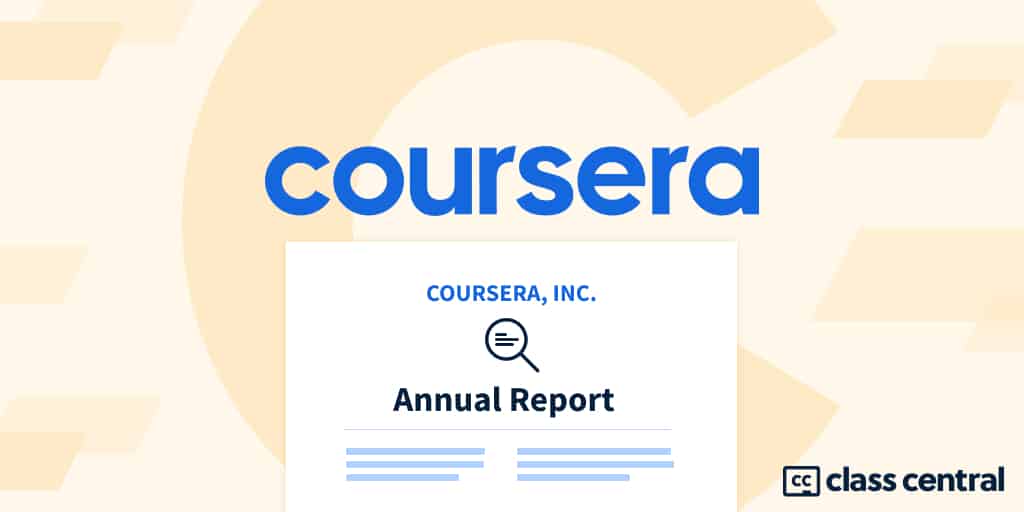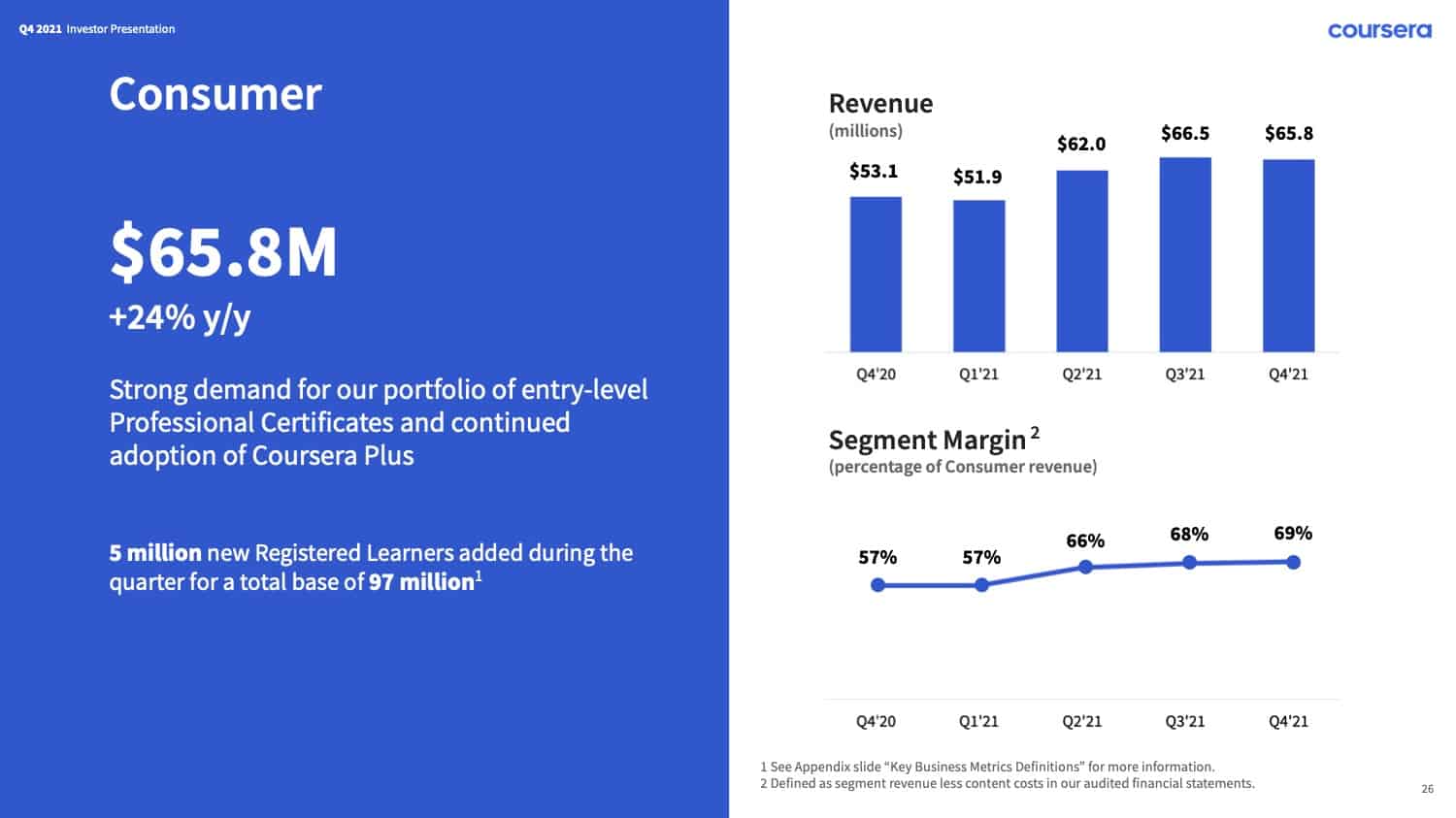

Coursera 10-K Highlights: Lower Partner Revenue Share, 1k+ Employees
source link: https://www.classcentral.com/report/coursera-annual-report-10k/
Go to the source link to view the article. You can view the picture content, updated content and better typesetting reading experience. If the link is broken, please click the button below to view the snapshot at that time.

Coursera 10-K Highlights: Lower Partner Revenue Share, 1k+ Employees
Coursera’s annual report gives us a deeper look into the company’s finances.

Just like I did with 2U, I read through Coursera’s annual report (also known as a Form 10-K) to learn more about the company’s 2021.
I’d previously written about Coursera’s 2021 using, among others, information gleaned from the company’s quarterly reports. But Coursera’s 2021 annual report, like their IPO S-1 prospectus, has nuggets of information that can’t be found in quarterly reports, including:
- Employee count: Coursera had 1,138 employees by the end of 2021.
- External revenue: 49% of Coursera’s 2021 revenue comes from outside the US.
Two statistics that stood out to me:
- About 32% of Coursera’s revenue came from the courses and programs of 5 partners.
- About 66% of their consumer revenue came from learners registered before 2021.
Let’s delve into the numbers.
Lower Revenue Share for Content Partners
2017 2018 2019 2020 2021
Consumer Gross Profit $43.7m $57.6m $64.6m $106.5m $162.5m
Consumer Gross Margin 50% 54% 53% 55% 66%
Enterprise Gross Profit $4.7m $19.0m $34.2m $49m $80.7m
Enterprise Gross Margin 64% 71% 71% 69% 67%
Degrees Gross Profit $2.5 $7.4m $15.1m $29.9m $48.8m
Degrees Gross Margin 100% 100% 100% 100% 100%
Coursera’s gross margin is now 60% compared to 53% a year ago. There are two major reasons for this:
- The segment revenue balance has shifted towards Enterprise and Degrees.
- The content costs in the Consumer segment have gone down.
This second reason means they’re sharing less with their partners. Here is a table to illustrate it:
Consumer Enterprise
Content Cost % of Revenue Content Cost % of Revenue
2020 $86.4m 45% $21.8m 31%
2021 $84.7m 34% $39.2m 33%
In 2021, even though Coursera’s consumer revenue increased by $53.3 million, their university partners only received 34% of the total revenue, while they’d received 45% the previous year. As a result, partners were actually paid less in 2021 than in 2020.
If Coursera had shared the same percentage of their revenue with their partners as they did in 2020, their partners would have made $27 million more in 2021.
According to Coursera, the shift was due to a shift to sales of subscriptions:
Consumer Segment Gross Margin increased from 55% in the year ended December 31, 2020 to 66% in the year ended December 31, 2021 due to a greater proportion of Consumer Revenue generated from sales of subscriptions with no associated content cost.
Coursera officially launched Coursera Plus in Feb 2020. Later that year, Coursera Plus Monthly started testing and was rolled out over 2021.
From the company’s Q4 investor presentation, you can see a sudden jump in Segment margin during Q2, 2021.

DeepLearning.AI Revenues
Revenue
2019 $5.9 million
2020 $6.1 million
2021 $6.5 million
Total $18.5 million
In their S-1 prospectus, Coursera declared how much it paid Deeplearning.ai — the company of Coursera’s co-founder and Board Member Andrew Ng — which offers courses on the platform.
In the 10-k, it refers to Deeplearning.ai as a “related party”:
During the year ended December 31, 2017, the Company entered into a content sourcing agreement with a related party in the normal course of business. Content fees earned by the related party during the years ended December 31, 2019, 2020 and 2021 were $5,876, $6,171, and $6,558, respectively.
These numbers are different from the ones Coursera disclosed in their S-1.
Back in 2017, almost six years after he introduced his Machine Learning class, Andrew Ng announced that he would launch a Deep Learning Specialization. Since then, DeepLearning.AI has expanded to 70+ courses and specializations.
Most notably, Deeplearning.AI courses are not part of the Coursera Plus subscription. This probably means that they get a higher percentage of the revenue share.
Learners and Enrollments
Coursera’s top five countries by registered learners are the following:
- United States — 18.1 million learners
- India — 14.9 million
- Mexico — 5.0 million
- Brazil — 3.9 million
- China — 3.4 million
According to Coursera, in 2021, learners enrolled in courses 37 million times, watched 372 million lectures, and completed 63 million assessments. Coursera for Business learners enrolled in courses 1.8 million times.
Hosting Expense
In March 2021, Couresra entered a five-year agreement with a cloud hosting provider committing to spend $7.5 million each year for the next five years.
If I had to guess who the provider is, I’d say Amazon Web Services (AWS).
Recommend
About Joyk
Aggregate valuable and interesting links.
Joyk means Joy of geeK